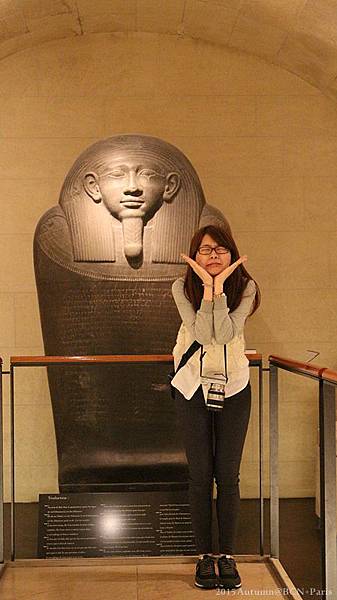
接下來,就讓我流水帳的紀錄一下我們在羅浮宮的參觀路線吧。
每個人喜歡的參觀方式不同,旅遊書上也各有推薦,也有朋友說先上頂樓在逛下來人比較少,
不過每個人適合的方式因人而異,還是依自己有的時間做極大化調配為佳。
我們參觀的方針大略是,依不同色塊/展區沿著順序把該色塊都看完,之後在移動到下一個色塊,
這樣腦筋比較不會錯亂,一下看美索不達米亞又一下踏入中古歐洲之類的XD
(文章內都設有連結連回羅浮宮網站,可以參考雕塑文物的更詳細解說)
。羅浮宮你好,初次見面,Nice to meet you!
我們第一次到羅浮宮是10/5(星期一),當天原本預計是要參觀西提島,
不過出門的時候就知道今天天氣不好,便想說看能走到哪就到哪,如果開始下雨,
就去羅浮宮吧!!! Museum Card一開通,真的是超方便,所有的行程都可以任意搭配,
而且西提島離羅浮宮也不過就是一站捷運站的距離,用走的也可~
果不其然,在排隊登聖母院塔時,天空便開始飄起毛毛雨,接著雨勢有越來越大的趨勢,
在聖母院排隊登塔時又得知K先生的iPhone 6 Plus離我們而去的噩耗……
總之,我們是在一個淋著雨、掉了手機、有點餓、對人性有點失望、非常狼狽的狀態下踏入了羅浮宮。
還好在馬利咖啡Café Marly稍做休息,看著外面撐傘還是跟金字塔開心合照的行人,
然後用Museum Pass,快速且順利的踏入羅浮宮乾燥溫暖的懷抱,
把所有行囊免費寄放在高科技寄物櫃後,可以說羅浮宮慷慨的接納了我們,
我們也開心的投入他的懷抱,把iPhone 6 Plus離我們而去的哀傷轉換成對稀世珍寶的禮讚,so positive!
[1st Stop – 黎塞留館Richelieu]
一個揮手致意的概念......
很多人說因為黎塞留館Richelieu缺乏重要館藏,所以人潮稀少,
可是我卻覺得這裡是我在羅浮宮中相當喜歡的一個地方。
諾大的中庭上面由玻璃罩帶入採光,大型雕塑們舒散的擺放各處,讓追逐的情侶、駿馬、天使、甚至是獵豹們,
都有空間恣意伸展。說是恣意伸展絕對不誇張,
因為每個雕塑都相當活靈活現,晚上各個都動起來也不嫌誇張。
這裡有許多原本是擺在凡爾賽宮的雕塑,現在為了保存移到羅浮宮內,後來在凡爾賽宮的花園裡看到石膏灌模的複製版後,
真真正正的誠心推薦大家來這裡看原版,神韻、細緻程度、肌膚肌肉紋理與大理石紋理的結合,
只有原作可以充分展現。
[黎塞留館Richelieu西半部 – 地下一層 馬利中庭(Cour Marly)]
展覽品:法國雕塑
**羅浮宮官網 Quote**
马利中庭的名称来自马利城堡。这座城堡建于17世纪,是路易十四暂避凡尔赛宫庭嘈杂琐事的地方。
城堡花园里展示着多尊王室定制雕像,主要是路易十四时期定制的作品,也有路易十五时期的定制
[如著名的《马利骏马》(Chevaux de Marly)]。
这座城堡毁于19世纪,此后,花园中的雕塑就移至卢浮宫的马利中庭展出。
這裡有一個羅浮宮所認定的鎮館之寶 - 《馬利駿馬》(Chevaux de Marly)
總共有兩座擺在高處,所以其實有點難拍照。
**羅浮宮官網 Quote**
这两座大理石雕像刻画了驯马师驯马的场景,国王路易十五(Louis XV)约于1739年
定制这两尊作品用来装饰巴黎不远处的王室宫邸马利城堡公园的水池。
《马利骏马》的新颖之处在于其创作没有参照任何神话或寓言。
雕像展现的只是原始本性,两股蛮力之间的对抗——一匹尚未驯化的烈马和一位裸身男子,
在使力的过程中结实的肌肉绷紧拉张开来。
起伏不平的土壤上的芦苇和石块代替了柯塞沃克斯雕塑上的军事战利品饰。
种种迹象可以看出这匹粗颈强壮的烈马的惊恐和愤怒:马身直立上仰,马嘴嘶吼,鼻孔和眼睛张大以及鬃毛立起。
难以驯服的野性欲再次挣脱束缚。观众无论站在哪个角度观赏,都可以清晰地感受到动态、力量和对抗的激烈。
艺术家观察人马抗衡实例,从自然状态汲取创作灵感。
这座雕像捕获瞬间动态,预示出下个世纪浪漫主义作品的盛行。
現場看這略比真人還要大的雕像(兩座都高約3.4公尺)真的很震撼,
但如果他可以放低一點就更好啦XD
BUT,不知道為什麼,可能是因為太難拍照了,或者是因為對於駿馬掙扎不忍,
K先生跟我完完全全沒有拍到《馬利駿馬》的照片阿.......是要再去一次的意思嗎XD
《馬利駿馬》的遠照,請看下圖照片中間上方.....(哭泣)
馬利中庭展出了許多動物相關的雕塑。
獵山豬。
Amphitrite(海后)
**海后小故事**
海后安非特里忒 (Amphitrite) 是老海神涅柔斯 (Nereus) 美麗的女兒。
有一天她和姐妹們在奈克索斯島 (Naxos) 上玩耍,波塞冬 (Poseidon) 一見傾心,撲了過去。
仙女驚恐之際潛入海底,她向大洋神俄刻阿諾斯 (Oceanus) 求助,並被掩藏起來。
但是安非特里忒 (Amphitrite) 的藏身處被海豚德菲紐斯 (Delphinus) 發現了,
於是它領著波塞冬 (Poseidon) 找到了安非特里忒 (Amphitrite)。海神滿心感激,
就把這隻海豚變成了海豚星座,把它放在天空中星星之間,使之永生不朽。
**羅浮宮官網Quote**
Amphitrite was the wife of the Greek god of the sea, Poseidon (the Roman Neptune). She is portrayed as a Nereid, a sea-nymph, as in classical representations of marine triumphs such as Raphael's Triumph of Galatea (Galleria Farnese, Rome). Semi-reclined on drapery, she is leaning against a dolphin that she is restraining with a cord. Prou gave her a generous, supple, curvaceous body. The drapery accompanies her curves, emphasizing the small of the back, climbs delicately over her shoulder to accentuate her breasts, and wraps itself around her left leg. There is a slight smile on her impishly graceful face. The sculpture's elegance owes much to the care the artist lavished on its details: the nymph's laurel-crowned hair, the braid border of the drapery, the plaiting of the dolphin's cord, and the aquatic vegetation.
話說......我看了這個導覽才知道原來那隻鯉魚是海豚XDD
和相對應的河中仙女雕像。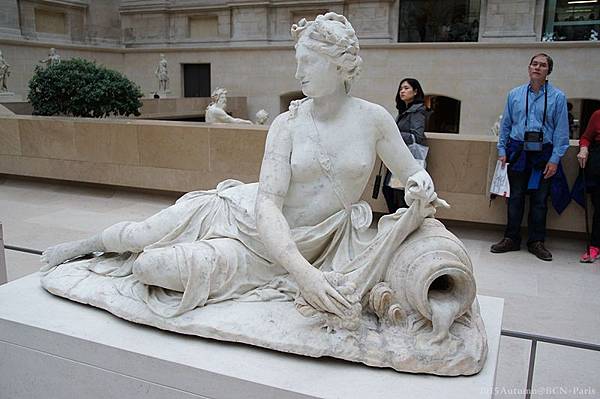
這張照片可以看到他們姿態優雅柔美的背面。
另外一組 Amphitrite and Neptune ,也是兩個成對的大型雕塑。
接著是有點容易和馬利駿馬搞混的 Fame and Mercury。
不過這兩匹馬顯然比較開心啊,上面坐著的神仙們也很開心XD
其實這雕的是訊息之神莫丘利 (Mercury,上圖) 騎飛馬佩加索斯,
與名譽女神 (Fame,下圖) 一樣騎著飛馬佩加索斯 (Pegasus),具有明顯的歌功頌德的意涵。
**羅浮宮官網Quote**
The resulting sculptures represented Fame and Mercury, each astride the legendary winged horse Pegasus, symbolizing the king's peacetime and wartime prestige. Both horses rear above military trophies representing the king's victories. Pegasus (the symbol of poetry) is guided by Mercury, the divine messenger and god of trade (symbolizing the benefits of the return to peace). The trophies under his rearing horse include a shield evoking the Spanish Succession, with Minerva (the goddess of war) presenting the portrait of Philip V to the Spanish people.(上圖)
The statue of Fame, wearing a laurel wreath and holding an olive branch, is sounding the trumpet of truth to proclaim the king's warlike strength. The trophies here include a shield adorned with a winged Victory holding a palm and crown. The lion skin evokes Hercules, the mythological hero of legendary strength, to whom the king was often compared.(下圖)


走上兩邊的平台,會遇到兩小無猜的Apollo (chasing Daphne) and Daphne (chased by Apollo),
上面的名字有夠繞口XD
現場跟K先生即席講了一段阿波羅不小心把愛神箭射到自己,然後追愛不成,害對方怕的變成月桂樹的故事。
**羅浮宮官網Quote**
Apollo almost topples forward, intent on his goal, his body forming a diagonal with his outstretched arm and leg. His speed is also expressed by his billowing drapery and windblown hair. Daphne is about to be caught, and shows her fear: her expression is theatrical and her body looks dislocated, its limbs in all directions. She reaches out imploringly, the disarray of her tunic reflecting her plight. A tree trunk stabilizes the sculptures - a veritable technical feat in view of the fragility of marble.
These statues have all the impetuousness of Roman Baroque, without its dramatic strength. Their slender elegance and vivacity suggest the advent of rocaille, the graceful, decorative style that emerged in early 18th-century France.
還有一組有點詭異的酒神娃娃XD
感覺就像是在強迫羊吃葡萄葉阿.......

咱們來看看K先生都拍了些甚麼??? (以下為K先生作品)
噓,不要看很可怕。
這.......
恩.....好,讓我們移動到另外一次的皮熱中庭(Cour Puget)吧!?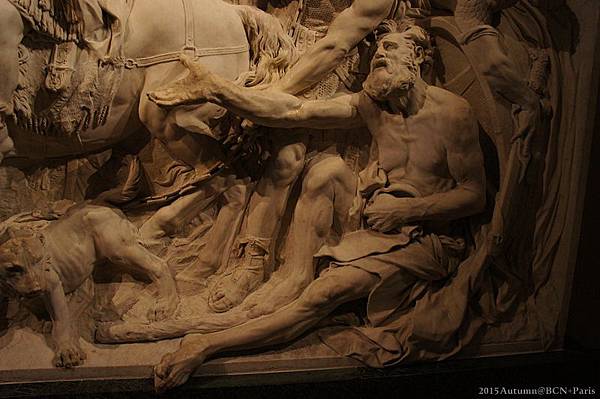
[黎塞留館Richelieu東半部 – 地下一層 皮熱中庭(Cour Puget)]
展覽品:法國雕塑
**羅浮宮官網 Quote**
建于十九世纪拿破仑三世统治时期的皮热中庭,顶部为玻璃罩覆盖,
庭内陈列十七、十八和十九世纪的露天雕像作品。
奴隶像,浅浮雕和奖章,这些都来自巴黎城内17世纪为彰显路易十四伟大功勋而建造的纪念碑。
这里展出的室外雕塑作品曾经是王室(凡尔赛、杜勒伊)及贵族园林和住所的点缀,
其中一些也曾是巴黎私人宅邸里花园的装饰。
這裡主要是展示了雕塑大師皮埃爾•皮熱(Pierre Puget)的作品,
最有名是Milo of Croton(克羅頓的米隆,a.s.a.手卡在樹裡的米隆XDD)
**羅浮宮官網 Quote**
米隆是一位著名的希腊运动员,他于公元前6世纪生于意大利的克罗顿(当时为希腊殖民地),
曾多次获得奥林匹克运动会和皮同运动会的冠军。
年老以后,为了看看自己是不是还老当益壮,他尝试劈开一根已裂缝的树干。
他的手夹在了树干中,动弹不得,最后不幸被狼群撕吞。
在这件雕塑中,艺术家用更高贵的动物——狮子替代了狼群,创造出极富戏剧性的效果。
一个对于人性的深思
17世纪法国雕塑家皮埃尔•皮热于1671年开始创作《克罗顿的米隆》,直到1682年才完成。
这个主题之前从未在雕塑作品中出现过,它不仅是对于时间战胜人力的思考,同时也反思了人类的骄傲:
米隆首先被自己的虚荣所战败,因为他拒绝承认年老体衰这一事实。
他的痛苦既是精神上的,也是身体上的。正如倒在米隆脚边的运动会奖杯所寓,人的辉煌转瞬即逝。
这个主题奇异而又大胆,因为这个作品是为国王路易十四(Louis XIV)而作。
无与伦比的构造
虽然皮热对雕塑的每一面都精工雕刻,但是他重点刻画了正面:
这个作品设计的观看角度是正面或四分之三角度。米隆的身体痛苦地扭曲,形成一个巨大的之字形,
而身体的三条主线,即腿部线条、上身线条和在撕心裂肺的嚎叫中向后扭转的头部线条,逐渐收缩。米
隆支在树干上的身躯,构成了这个作品的中心轴线。
在中部,大理石被凿出两个透光口凸显出运动员的轮廓:
这种将基座镂空的设计在雕塑中很少见,减少了雕像的支撑,是一项技术创举。
皮热和古代作品
皮热雕塑米隆时,脑海中肯定浮现出希腊化时代的一件刻画拉奥孔(Laocoon)的作品。
拉奥孔是希腊神话人物,被艺术家们视为悲剧英雄范例。这位老人被神明派来的蛇勒住而窒息,淡定死去。
然而,皮热创作了一个现代作品:他没有理想化地表现主人公,
而用痛苦激烈的表情替代古代雕塑作品中的平和安宁。
米隆的身躯因痛苦而弯曲成弓形,面部强烈扭曲,挛缩的脚趾深深陷入土中。
这座雕像1683年在凡尔赛宫展出时,路易十四的妻子、王后玛丽•泰蕾莎(Marie-Thérèse)曾忘情地嚷道:
“可怜的人啊!”皮热的精湛雕塑技艺使人忘记了这只是大理石塑雕:
狮爪看上去深嵌肉体。紧绷的肌肉,突起的青筋以及抑扬变化的表面使人感受到肉体的颤抖。
雕塑家使人体的光滑肌肤与其它部分的粗糙形成强烈对比:狮毛用凿子雕琢,而树干和泥土用刀尖刻画。
通过不同的表面处理,作品区分了故事中的三个主体:人、兽和自然。
BUT,K先生還有我,當然是一張米隆的照片都沒有拍到阿.....
(到底在幹甚麼.....)
當時在皮熱中庭,最喜歡的是Pierre Puget下面這座:
柏修斯 (Persus) 取了蛇髮女巫梅杜莎的首級後解救安卓玫達公主 (Andromeda)
兩人手交疊的姿態柔美、繾綣纏綿,Persus異於常人的高大壯碩,
與嬌小的Andromeda形成強烈對比,兩人的肌肉曲線,陽剛與柔美充滿衝突卻又和諧。
還有使用完後就被棄置的梅杜莎之頭,整個很有戲阿XDD





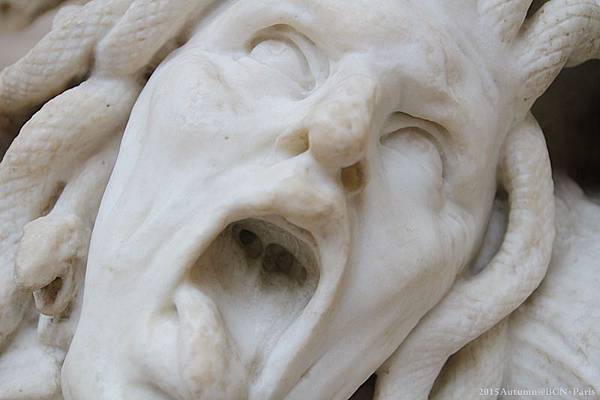
另外也喜歡,春夏秋冬裡的冬天老人。
仕女與拿著面具的登徒子。
有小小愛神在旁邊推波助瀾,仕女看起來一整個欲拒還迎,登徒子的手都摸到大腿上了說~
愛神教導邱比特射箭,也是我們兩個都很喜歡的作品。


兩個黎塞留館Richelieu底層的中庭都細細瀏覽過後,步上階梯,到Ground Floor。
[黎塞留館Richelieu西半部 – 一層Ground Floor小展覽廳1-18]
展覽品:法國5至18世紀雕塑
小展覽廳1-18(順時鐘)主要是偏宗教雕塑、棺飾,這部份我們比較沒有興趣所以快快看過,
不過還是有許多讓人耳目一新的作品XD
在羅浮宮時不時就會遇到華麗的樓梯間~
Daniel in the lions' den,柱飾上的小獅有點萌!
**羅浮宮官網Quote**
This capital, characteristic of Romanesque sculpture, has certain antique elements (corner scrolls, central adornment) but is historiated. The seated figure of Daniel is perfectly adapted to the space; the lions' heads on either side accentuate the load-bearing function of the scrolls. The lions are freely interpreted from oriental models, and stylized in a highly decorative manner. Daniel's relatively naturalistic features contrast with the almost abstract graphic design of the drapery.

從Room 1-6 望出去的景色,外面下著不小的雨,樓下就是Cafe Marly,
兩個人很愜意地坐在那裏。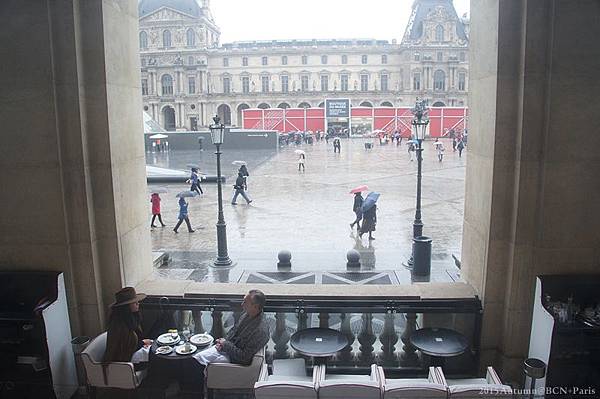

以前的國王手裡都要捧教堂、城堡,聖索菲亞大教堂裡的康士坦丁大帝就捧著整座君士坦丁堡阿。

這裡看完之後又回到底層,前往黎塞留館Richelieu的東半部。
[黎塞留館Richelieu東半部 – 一層小展覽廳25-33]
展覽品:法國18至19世紀雕塑
首先是經典中的經典,老梗中的老梗,麗妲與色天鵝-Leda and the Swan。
**羅浮宮官網Quote**
The god Jupiter fell in love with Leda, the mortal queen of Sparta. He came to her in the form of a swan, and seduced her while she was bathing in the river.
Thierry's libertine style
Leda was a recurrent motif in erotic art from the Italian Renaissance, treated by artists such as Da Vinci and Michelangelo. Thierry's approach to the theme has voluptuous elegance and grace. Leda's pose (sitting with one leg bent behind her, one arm across her body, and her head in profile) was inspired by the Nymph with a Quiver and Nymph with a Dove (in the Louvre) by Coustou, Thierry's master at Versailles. In this work, however, the contrapposto is accentuated, and the attitude more lascivious. Leda's body is brought to life by the upward movement of the swan that envelops her with its wings, its webbed foot on her left thigh; she is turning to the swan, her right hand on its shoulder, her left caressing its neck. The protagonists are gazing into each other's eyes with obvious desire. The spiraling forms intertwine in a swirling shape that confers a multitude of viewpoints to the group. The sculptor played with textures too, using the ridges on the swan's feathers, Leda's braided hair, and the grooves on the plinth, to highlight the smooth sheen of the queen's body.
這個小房間充滿了各種力與美的動態雕塑。
比如說下面這個佛山無影腳 vs. 河東獅咬,我猜應該是河東獅咬贏~ 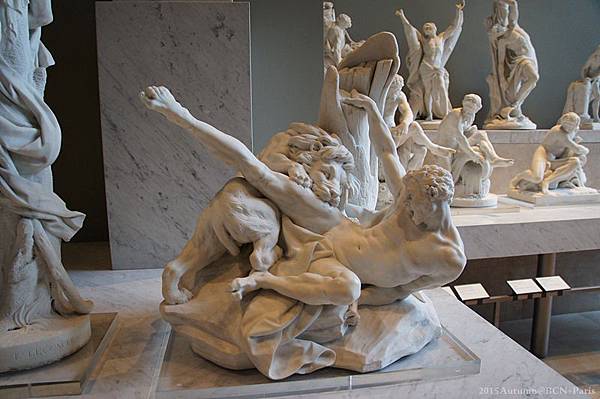


在Psyche Abandoned身後被一波波藝術賞析轟炸的K先生正在看窗外的雨景。
賽姬 (Psyche) 與邱比特 (Jupiter) 的故事我一直很喜歡,因為是很難得的終於兩情相悅後,有情人終成眷屬。
而且難得沒有再出現甚麼婚後出軌的情形,從一而終給著讚!
所以出發前也逼著旅伴惡補完賽姬與邱比特的故事。
**羅浮宮官網Quote**
Alone and in despair, Psyche mourns the flight of Love, which she has involuntarily provoked. Despite having been forbidden as a mortal to look upon the god, Psyche could not resist discovering who was her lover at night. While Cupid slept, she watched him by the light of an oil lamp; moved by his beauty, she spilled a drop of oil. Cupid awoke and fled. The butterfly near Psyche symbolizes the soul (psyche in Greek). The lamp and a dagger (which she carried in case she encountered a monster) lie on the ground.
拿破崙還真好認,所有的雕像不管是真人大小還是放大版,
他的五五身材比例總是若隱若現。
來看看K先生都照了些什麼!?
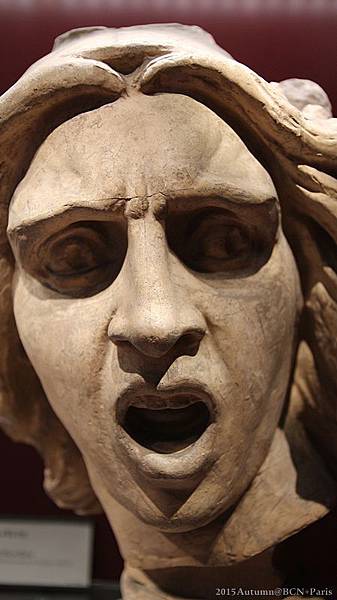
恩.......讓我們移動到下一個色塊吧....... 美索不達米亞!!!
[黎塞留館Richelieu東半部 – 一層科撒巴德庭(Cour Khorsabad)]
展覽品:美索不達米亞文物
**羅浮宮官網 Quote**
在这个卢浮宫的内庭内,展示着萨尔贡二世建造的科撒巴德城的大量遗物,让人叹为观止。
科撒巴德城位于今日的伊拉克境内,在公元前706年落成。陈列时还原了浮雕最初的构图,
让其精妙的构思和不朽的建筑艺术得以凸显。
從展覽廳1一直晃到21,一路便沿著中東古文明的足跡前進,
從美索不達米亞、古伊朗、一直到近東地區,
地域的遼闊、漫長的歷史時期中,有許多或許相似的不同文明接替延續。
這裡有一個其貌不揚卻超級有名的鎮館之寶-漢摩拉比法典(Law Code of Hammurabi, king of Babylon)。
**羅浮宮官網 Quote**
《汉谟拉比法典》是兴盛于中东地区(今伊拉克所在地)的美索不达米亚文明的象征。
这座由巴比伦国王在公元前十八世纪建造的高大的玄武岩石碑,既是一件艺术品,
也是一件历史和文学作品,还是在圣经法典之前的古代最全面的司法典籍。
司法传统
这座两米多高的玄武岩石碑由巴比伦的汉谟拉比王(公元前1792-1750年)建造,
地点可能在西巴尔——掌管司法的太阳神沙玛什之城。
石碑的其他复制品被放置在汉谟拉比王朝的其他城市中。
汉谟拉比王出现在石碑的上部:立于左侧,头戴高边王冠,
向坐在面前的神明致礼。神明头戴牛角形圆锥帽冠,标志着其神圣的地位。
人们猜想这就是太阳神沙玛什,法律的执行者,其标志就是肩头喷出的火焰。
沙玛什将象征王权的戒指和权杖递给汉谟拉比。
汉谟拉比王的石碑为古美索不达米亚最辉煌的王朝之一作出了总结。
法典成于汉谟拉比王晚年时光,因而它也是写给未来王储的政治遗言,
为其提供了智慧与公正的理想范本。
法典还作为文学范本在专门培养书吏的学校里被世人抄写了千年之久。
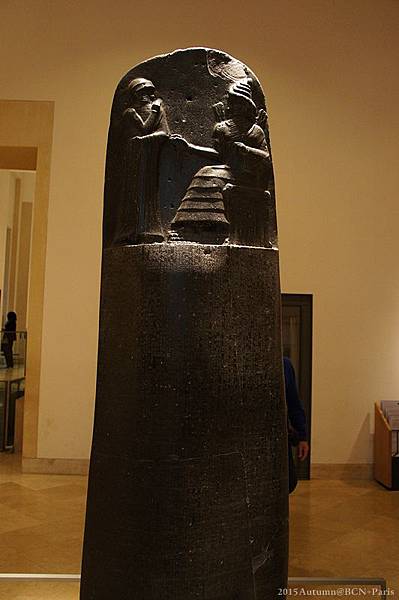
只想說~來人阿,給我唱一首 愛在西元前~

膜拜完漢摩拉比法典後,接下來是挑選寵物的時間,
我們看到了好多可愛的大小獅子。
小耳朵方臉獅,讓我想到 我可能不會愛你 裡面的方臉獅。
看起來有點衰的綠色獅子~拜託,請養我吧!
Statue of a lion
**羅浮宮官網Quote**
This bronze lion was discovered during excavations at Mari, a wealthy city in the region of the Middle Euphrates. It was found inside a temple dedicated to a deity known as "King of the Land," together with an almost identical companion statue, which is today housed in the museum of Aleppo, Syria.

很神奇的小滾輪印章 - Cylinder Seal
太大隻了,請勿餵食。
牛身人面有翼的神獸巨像(Lamassu / Winged human-headed bull),
是薩爾貢二世(Sargon II)擺在宮殿的裝飾品,同時也有支撐屋頂的功能。
表情有種詭異微妙的平和,很像是K先生快要生氣或者進入陰晴不定mode的樣子。
**羅浮宮官網 Quote**
Human-headed winged bulls were protective genies called shedu or lamassu, and were placed as guardians at certain gates or doorways of the city and the palace. Symbols combining man, bull, and bird, they offered protection against enemies.
A monumental sculpture
Carved from a single block, it stands more than 4 meters high by 4 meters wide and is a meter in depth. The head is sculpted in the round, the rest of the body in high relief. High relief was much prized in the time of Sargon II, when modeling became more marked. The head, the only human element, whose ears are those of a bull, has a man's bearded face with very precisely modeled features. The eyes are expressive, the thick eyebrows meet above a prominent nose. The kindly mouth is surmounted by a thin mustache. A curly beard covers the jaw and chin, while the hair falls down to the shoulders, framing the face. This human head wears a starred tiara, flanked by pairs of horns and topped by a row of feathers.
The body, its anatomy very precisely rendered, is that of a bull: the beast has not four but five legs, so that it looks as if standing still when seen from the front, and as if walking when seen from the side. From the shoulders spring the wings of a bird of prey, only one being visible, curving above the back; broad panels of curls cover the breast, belly, back, and rump. The tail is very long and curly at the end. An inscription on two panels between the hind legs of the bull praises the ruler by rehearsing his virtues and calls down a curse on whomever should seek to harm the edifice.
These bulls are motifs of Syrian inspiration and one of the characteristic features of the decoration of Assyrian palaces. They make their first appearance at Nimrud in the reign of Ashurnasirpal II, to disappear again after the reign of Ashurbanipal.

在Lamassu前面也要放閃的歪國人~
美索不達米亞告一段落,我們也走到轉折點了,要繼續我們的中東旅程,
就要轉向敘利館 Sully,外頭仍然是陰天。
[敘利館Sully北半部 – 一層Antique Iran]
一開始先看到很多青銅器的動物。下面這隻像馬又像鹿,莫非是馬鹿!?
羚羊角也是常出現的一種圖騰。
這真是有種說不出的詭異......
這隻跟宮崎駿的魔法公主裡面的森林之神好像!
仔細看他其實是踩著Silene神的面具上飛耀起來,而且回來後才發現,
原來他是當時某個瓶的耳柄,做的實在十分精緻。
Vessel handle in the form of a winged ibex with its hooves resting on a mask of Silenus
**羅浮宮官網Quote**
The fine detail on the body of this winged ibex, a hybrid creature depicted on the point of leaping, has been achieved by use of the lost-wax technique. The elegant wings and huge horns underline the energy of the animal's pose. Its back legs rest on a mask of Silenus, a figure associated with the cult of Dionysus and wine-drinking, alluding to the function of the metal vessel.

接下來又來個大型的牛頭梁柱。
Capital of a column from the audience hall of the palace of Darius I
能夠把這麼大型的東西帶回來,實在是需要一點偏執阿.....
**羅浮宮官網Quote**
This colossal capital from one of the thirty-six monumental columns which supported the roof of the apadana at Susa is evidence of an architectural tradition purely Iranian. It is typical of Achaemenid art in combining elements taken from different civilizations to form a coherent stylistic ensemble.
細看牛頭做得維妙維肖,有著美麗的弧度。
牛有對玫瑰瞳鈴眼XD


在離開伊朗前,K先生很喜歡的一個作品"波斯的弓箭手",
他是由釉面磚所裝飾的一個牆面,所以能夠將色彩從西元前510年保留到現在,
每個弓箭手都有些微不同,從裝束還有皺褶明顯的花紋長袍,
還有那個小小捲捲的鬍子-波斯人無誤!!!
類似文物


看到以下文物會讓你想到甚麼!!!???
是否不由自主地想要做出這個動作呢!?!?(還是只有我有這個症頭XD)
是的,當你看到這座雕像並經過他前面時,表示你已經離開"長得全部都很像的近東地區",
踏入了有點熟悉(主要來自神鬼傳奇-印和闐),卻其實不怎麼了解(尤其是那些頭上頂著不同東西的神)
的埃及區了,這一區在敘利館Sully的最東側。
[敘利館Sully北半部 – 一層Themed Circuit Egyptian Antiques]
他其實是Sarcophagus of Eshmunazar II, king of Sidon(某個國王的石棺)。
國王的面容安詳,而根據羅浮宮官網描述,它的特色在於棺體上的超長敘述,
基本上就是:
詛咒(打擾我安眠的人不得好死)+帝國敘述+詛咒(掀開我棺蓋的人不得好死),
是一個前呼後應的概念。
這個小東西有點太可愛,眼型跟我們常見的埃及人很不像,
我想是因為眼線style不同的關係,鬍子經過了這麼久的時間,依然茂密阿XD
晚上經過他,肯定會被嚇著。
老實說,下面這個貌似有點猥瑣的雕像出現時,如果不是知道自己身在埃及區,
我會以為他跟亞馬遜雨林裡吹箭的小矮人比較有關係,
沒想到回來一查,他其實是埃及的某一位神祇阿-god Bes,
但看羅浮宮的描述他比較像家事小矮人,然後這是一個花瓶,
而且是有錢人家的花瓶來著,恩亨,這種微妙的審美觀實在.......XD
Vase in the form of the god Bes
**羅浮宮官網Quote**
Bes is an atypical god — a dwarf, who does not have the elegant appearance of the other Egyptian deities, most of whom have ideal human or animal forms. He first appeared among the magical objects of the Middle Kingdom as a slender creature, always seen full face, bending his legs like a dancer, with a long tail down to the ground and lion-like ears. During the New Kingdom he acquired his definitive appearance: his belly and head grew bigger, he began to grimace, he grew a splendid beard, and he often sported a feather headdress. Bes did not have his own sanctuary. He adorned household objects, which he protected against poisonous animals and other dangers, and was often to be found on toiletry articles. He was a common feature around the eastern Mediterranean at the end of the Pharaonic civilization.
The god Bes is represented sitting on the floor with his knees up, his huge potbelly covering most of the almost square base. His fists, resting on his knees, once held two (now broken) metal snakes. His usual apparel, a panther skin, hangs over his pendulous breasts; he has a simple knotted belt around his fat belly. His disproportionate head is finely detailed: the flowing locks of the mane, the neatly combed beard, the creased forehead and stylized lion-like ears. The protruding tongue is of inlaid red stone; the eyes (now missing) were inserted into a black glass (perhaps obsidian) surround. It is a very valuable object therefore.

小吐香舌~
走過下一個轉角,又遇見他。
Statue of the god Bes,而且羅浮宮官網還再次強調,千萬不要"以貌取神",
god Bes當時可很受平民百姓尤其是孕婦歡迎,專門守護家庭和樂杜絕惡靈來襲,
但如果我突然在床單上或枕頭套上看到他,
應該有種很微妙的感覺吧~
**羅浮宮官網Quote**
Despite his rather unattractive appearance, he was a benevolent deity, and protected people during vulnerable periods by keeping malevolent spirits at bay. He was a particular favorite among pregnant women.
You can't judge a book by its cover
Bes's repulsive and even terrifying appearance put all harmful spirits to flight. He was extremely popular and was portrayed often. His image decorated the wall of certain rooms of a house such as the bedroom. It also appeared on beds and headrests, where he watched over people as they slept. His image was also used on certain toiletry objects, including mirrors and recipients for cosmetics and unguents, to increase their protective powers. His most important role, however, was to watch over woman throughout their entire pregnancies and during childbirth, just as he watched over the birth of the sun god.
He danced and played the harp, the tambourine, and the pan pipes, while making faces: all this noise and his grimacing drove away troublesome spirits. During the Late Period, he became a formidable composite god. He was also invoked in temples where he would send dreams to worshippers in response to their questions. He was a deity with multiple powers and was also considered to be a healing god.
這個我想也是他吧!?
埃及神祇實在多又複雜,在這裡有簡單的跟K先生上了一下課,但畢竟我也是個半吊子,
在此推薦一下造訪前拜讀的大作:[埃及] 一起來認識複雜的埃及神祇吧!
下次去埃及前,一定要再把這篇文章熟讀阿,寫得太有心了!!!
羅浮宮在這裡也有一個大板子介紹埃及主要神祇(不過是法文......),當然也是從太陽主神(Ra)開始,
頭戴圓球的八九不離十,常常是以鳥頭出現。
鱷魚神(Sobek),他以前統治埃及很久,後來化為法老的守護神,
BTW,除了貓以外,埃及人其實也很喜歡鱷魚,還會把他們做成鱷魚木乃伊喔!
狒狒神(Thoth),他是埃及的智慧之神,可能連小頭都很有智慧(對不起,我糟糕了.......)
常見的隼鳥神(Horus/荷魯斯/Orisis和Isis的兒子),他是法老王權的象徵,
常常以一種類似神奇寶貝的姿態很萌的登場。

貓咪女神(Bast),她有神祕的力量可以驅逐邪惡與疾病。
埃及人很喜歡貓咪,然後埃及人也很喜歡把貓咪做成木乃伊,
所以在這一區可以看到許多貓咪的大大小小雕像與木乃伊。



參觀到這些罐子的時候,先讓K先生猜猜他們是裝甚麼的,
猜不出來後在鉅細靡遺的告訴他木乃伊製作過程,還有這些罐子分別有守護的臟器要放在裡面,
是不是一趟很寓教於樂的旅程呢!!!
罐子外面的形象是來自Horus的四個孩子分別有他們各自的擬像與守護的臟器。
(右一)Duamutef-保護胃-。胡狼頭
(右二)Imset-保護肝臟-人形
(左二)Hapi-保護肺-狒狒頭
(左一)Qebshenuf-保護腸-獵鷹頭
The four canopic jars of Horemsaf (官網竟然還有打開裡面的照片,有興趣的民眾可以點去看看XD)
**羅浮宮官網Quote**
During the New Kingdom, the iconography used for canopic jar stoppers reproduced that of the Four Sons of Horus, deities who protected the internal organs: human-headed Imsety, baboon-headed Hapi, jackal-headed Duamutef, and falcon-headed Qubehsenuf. Each of Horus’s sons, paired with a goddess, was responsible for the protection of a particular organ: Imsety and Isis guarded the liver, Hapi and Nephthys the lungs, Duamutef and Neith the stomach, and finally Qubehsenuf and Selket the intestines.
The formula inscribed on the belly of each canopic jar also associated a son of Horus and a goddess. It quoted the protective words spoken by the goddess on behalf of the Son of Horus with whom the deceased was assimilated.

埃及象形文字,看起來很簡單,但要看懂很難(廢話)
埃及版的蒙娜麗莎的微笑,這種笑法可能跟陳冠希學的XD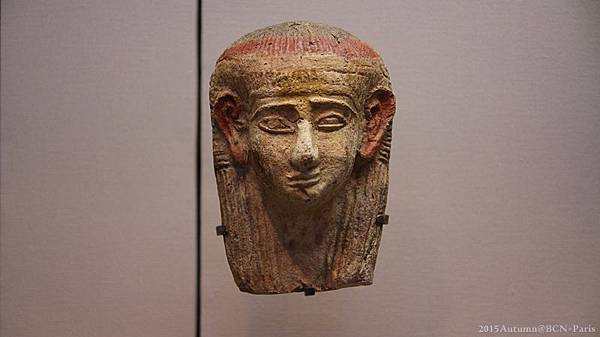
其實羅浮宮座位還不少,很多這種情人雅座可以休息或躲在裡面吃東西。
埃及區Room 14有一個參觀重點,就是各式各樣的人形棺,有兩大長櫃裡面擺了超多個,
好像來到的棺材店一樣,K先生還叫我選一副最喜歡的(......)
下面這一套是屬於一個知名歌手的(很妙,但官方導覽指南還有官網都說是位歌手來著)。
Tamutnefret's coffins
**羅浮宮官網Quote**
Tamutnefret, a singer of Amun, was buried in a superb set of two beautifully decorated coffins, with an openwork decorated wood top covering her mummy. These coffins present an idealized image of the deceased, represented as a wrapped mummy, like Orisis. The various spirits and deities depicted on each of the elements were meant to provide Tamutnefret with magical protection for safe survival in the afterlife.
在眾多副棺材中,我喜歡這一排的,因為他們看起來既圓滑又福相!
根據官網的說法,這是一個位高權重的希臘人,選擇了埃及式的葬禮方式,
而且石棺下方周遭寫滿了死者之書(ancient Egyptian Book of the Dead)的文字,
感覺起來就充滿了神祕性。
Sarcophagus of Dioscorides, a Greek Egyptian
**羅浮宮官網Quote**
Dioscorides was a general under Ptolemy VI, and is well known from a number of Greek papyri. Despite being a member of the Greek élite that governed Egypt at the time, he chose to be buried according to local Egyptian custom. He had his dark stone sarcophagus finely engraved, at appropriate places on the body, with religious inscriptions taken from the ancient Egyptian Book of the Dead.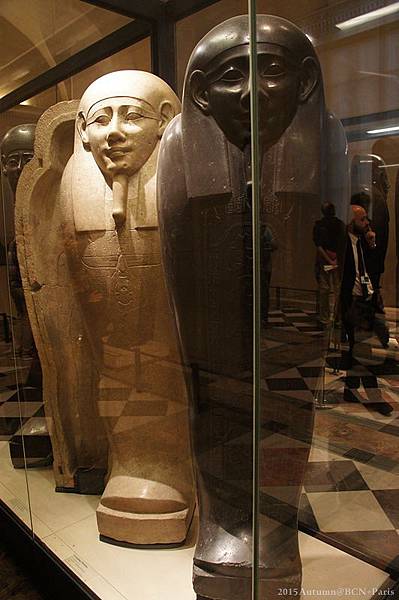
下面這張姿態奔放(ㄨㄟˇ ㄙㄨㄛˇ)的照片,想必又是K先生的大作.......
照這個頭中間有顆圓球,站著手持鞭子的姿勢,頭上像是戴有長條羽毛的裝飾,
推測應該是Amun(底比斯的地方神)+ Ra(太陽神)的混和體。
如果是平常日1800關門,羅浮宮會在1715開始廣播請大家要有心裡準備博物館要關門了,
然後廣播與館員會開始慢慢收網,把參觀人潮往出口方向趕,
這時候會有某些網上的樓梯關閉,只能往樓下的出口走。
被趕往出口時,留連忘返拍到的古代扭蛋系列,我想系列名稱是-綠色軍團。
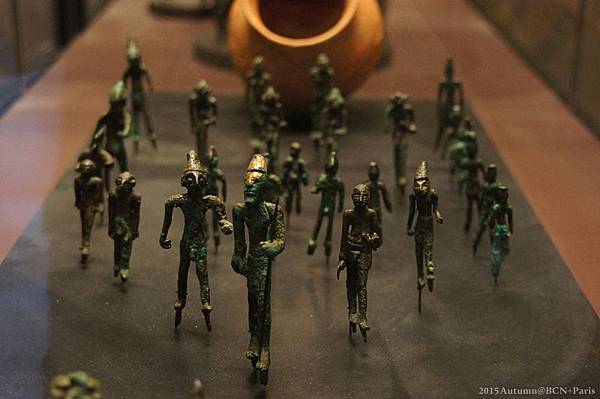
充滿生命力的容器。
當天下午1800,金字塔下方的眾多人潮。
經過了剛剛豐富的藝術與文化洗禮,我們準備要重返人世了XD
下一站就是約了1830要到蒙恬大街(Avenue Montaigne)拿昨天在Ferragamo調貨的鞋子,
整個瞬間回到俗世的感覺。
就這樣順利的完成了羅浮宮初訪,明天星期二休館,星期三再來看你啊~






 留言列表
留言列表
